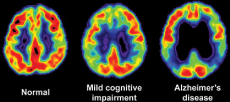
Alzheimer's is a disease that has become increasingly notorious within our modern society, and it seems that everybody knows somebody who is afflicted. It is feared on a similar level to cancer, or perhaps even more so, because within Alzheimer's, we appear to lose our very selves. After all, without our memories, what are we but mere shells? Memory is something we may take for granted, but to those with memory disorders and their families, everyday life is an ordeal. This is why a new breakthrough may provide hope for millions.
Scientists have known for a while that a primary cause of Alzheimer's has been Tau tangles, which occur when Tau proteins cease to function correctly, no longer stabilising microtubules. The Tau proteins consequently become twisted around each other, causing neurofibrillary tangles. When this happens, the microtubules disintegrate, which leads to a lack of communication between nerve cells, potentially causing neuronal death. Plaques also seem to present themselves in those suffering from Alzheimer's. Plaques are formed when proteins called Beytah -amyloids clump together. These masses inhibit signals between cells via synapses, which leads to the deterioration in memory; all of which creates a pathway for disease. But now, researchers have discovered a new usage for PET scanners in regards to the detection of these debilitating plaques and tangles.
PET scans, or positron emission topography, can produce three-dimensional images of any functional processes within the body. As such, a completely harmless chemical can be injected into the bloodstream of an individual, a tracer chemical, which collects in the tau tangles. A fluorescent light is subsequently emitted, which can be detected with a PET scan. This provides information about the precise location of the tangles. Makoto Higuchi, head of the team who have developed this revolutionary new system, hails the discovery as 'of critical significance' due to the fact that Tau lesions are thought to be a larger causational factor for the onset of Alzheimer's than the plaques in isolation.
This new tracer has already proved its worth, enabling scientists to learn that tau tangles seem to initially accumulate in the hippocampus, which is effectively the memory centre of the brain, when plaques are already prevalent. Prior research suggests plaques are relatively harmless, but may facilitate the spread of the disease, whereas tangles kill neurons at a rapid speed. Indeed, the scale of the tangles provides an indication of the progression of the disease; as such, treatment can now be more easily ascertained, particularly as early detection is now a possibility, with plaques developing as much as 10 to 15 years before other symptoms present themselves.
This breakthrough irrefutably provides us with the best chance we have of combating this neuronal disease. Now it is feasible to trial the effectiveness of drugs, chart progression and deterioration, and ultimately, deliver diagnoses as early as possible so treatment can begin. With constant research in the burgeoning field of neuroscience, we can now begin to hope to finally find a cure for these degenerative diseases that are ravaging our generation.
Image: http://www.berkeley.edu/news/media/releases/2009/07/14_alzheimers.shtml

0 Comment:
Be the first one to comment on this article.